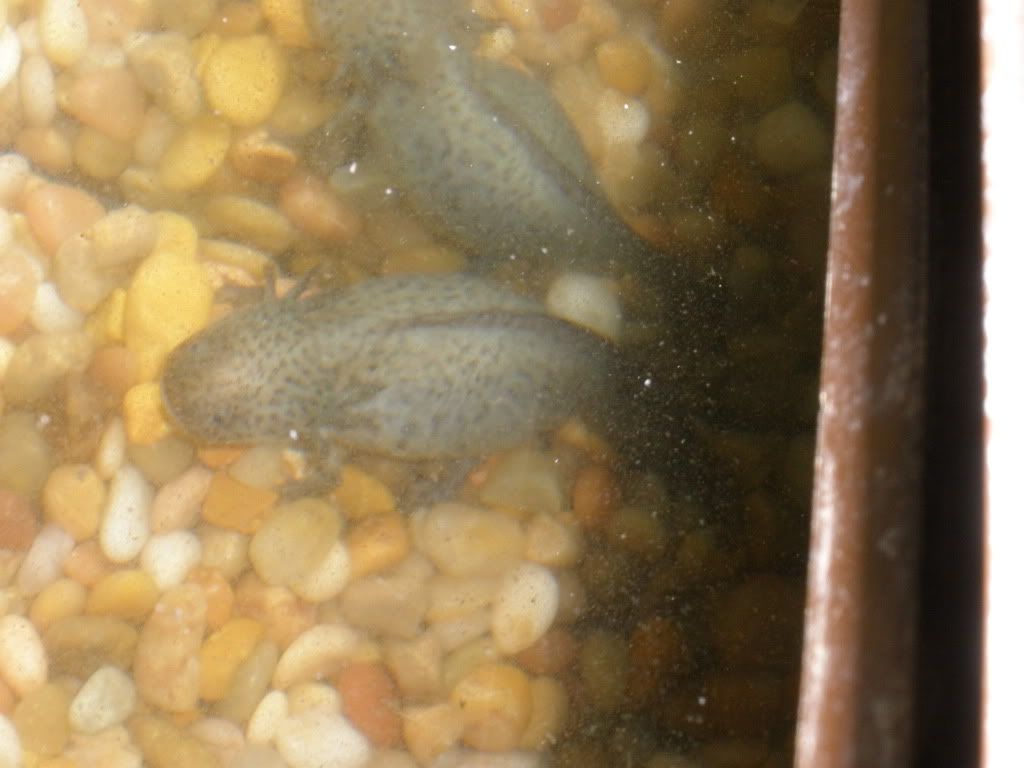CrazyBirdLady
New member
- Joined
- May 19, 2010
- Messages
- 8
- Reaction score
- 0
- Points
- 0
- Country
- United States
Hi Folks,
I have a wild-type axolotl named Widget. She lives in a 10 gallon tank with an AquaClear 20 filter set on low flow, no heater, and no light. The tank is located in a dark corner that receives no direct sunlight, and stays 65-ish degrees most of the time. The tank has a big rock, a piece of driftwood, and some plastic plants to hide in. Up until recently the tank had a large gravel substrate (this type). It has been completely removed. Widget is usually a very good eater. She gets mostly Hikari Sinking Carnivore Pellets (these), and the occasional guppy or minnow (I won't be feeding her any more pet store fish and am planning to set up another tank to breed guppies).
Last week when I went to clean her tank I discovered that she was bloated and had left her food uneaten. I read through the posts on this forum and concluded that she probably had a rock impaction. I put her in clean dechlorinated water in a tub in the refrigerator at 7 degrees C. She has been there for a week. Twice now I have seen a few specks of poo, but she is still quite fat. I have palpated her abdomen and found no rocks. Shining a high-power flashlight reveals all of her bones, but no rocks. I am wondering at this point if maybe an infection is causing her bloat. Her gills have begun to look "threadbare" for lack of a better word, kind of tattered and dark. I don't know if this is normal in refrigerated axolotls. I tried to offer her some frozen turtle food (this kind) which she has liked in the past, but she did not eat.
I know the best thing would be to take her to a vet who specializes in herps. Unfortunately I am currently financially dependent on my parents and they do not approve of spending a hundred dollars on a pet that isn't furry. So I need to do as much as possible on my own. Does anyone know what I should do at this point?
Here is a picture of her a week ago, just before I put her in the fridge and took out all the gravel. I would say she is about the same today.

Thank you in advance.
I have a wild-type axolotl named Widget. She lives in a 10 gallon tank with an AquaClear 20 filter set on low flow, no heater, and no light. The tank is located in a dark corner that receives no direct sunlight, and stays 65-ish degrees most of the time. The tank has a big rock, a piece of driftwood, and some plastic plants to hide in. Up until recently the tank had a large gravel substrate (this type). It has been completely removed. Widget is usually a very good eater. She gets mostly Hikari Sinking Carnivore Pellets (these), and the occasional guppy or minnow (I won't be feeding her any more pet store fish and am planning to set up another tank to breed guppies).
Last week when I went to clean her tank I discovered that she was bloated and had left her food uneaten. I read through the posts on this forum and concluded that she probably had a rock impaction. I put her in clean dechlorinated water in a tub in the refrigerator at 7 degrees C. She has been there for a week. Twice now I have seen a few specks of poo, but she is still quite fat. I have palpated her abdomen and found no rocks. Shining a high-power flashlight reveals all of her bones, but no rocks. I am wondering at this point if maybe an infection is causing her bloat. Her gills have begun to look "threadbare" for lack of a better word, kind of tattered and dark. I don't know if this is normal in refrigerated axolotls. I tried to offer her some frozen turtle food (this kind) which she has liked in the past, but she did not eat.
I know the best thing would be to take her to a vet who specializes in herps. Unfortunately I am currently financially dependent on my parents and they do not approve of spending a hundred dollars on a pet that isn't furry. So I need to do as much as possible on my own. Does anyone know what I should do at this point?
Here is a picture of her a week ago, just before I put her in the fridge and took out all the gravel. I would say she is about the same today.

Thank you in advance.
Last edited:



